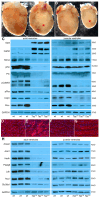A Barth Syndrome Patient-Derived D75H Point Mutation in TAFAZZIN Drives Progressive Cardiomyopathy in Mice
- PMID: 39125771
- PMCID: PMC11311365
- DOI: 10.3390/ijms25158201
A Barth Syndrome Patient-Derived D75H Point Mutation in TAFAZZIN Drives Progressive Cardiomyopathy in Mice
Abstract
Cardiomyopathy is the predominant defect in Barth syndrome (BTHS) and is caused by a mutation of the X-linked Tafazzin (TAZ) gene, which encodes an enzyme responsible for remodeling mitochondrial cardiolipin. Despite the known importance of mitochondrial dysfunction in BTHS, how specific TAZ mutations cause diverse BTHS heart phenotypes remains poorly understood. We generated a patient-tailored CRISPR/Cas9 knock-in mouse allele (TazPM) that phenocopies BTHS clinical traits. As TazPM males express a stable mutant protein, we assessed cardiac metabolic dysfunction and mitochondrial changes and identified temporally altered cardioprotective signaling effectors. Specifically, juvenile TazPM males exhibit mild left ventricular dilation in systole but have unaltered fatty acid/amino acid metabolism and normal adenosine triphosphate (ATP). This occurs in concert with a hyperactive p53 pathway, elevation of cardioprotective antioxidant pathways, and induced autophagy-mediated early senescence in juvenile TazPM hearts. However, adult TazPM males exhibit chronic heart failure with reduced growth and ejection fraction, cardiac fibrosis, reduced ATP, and suppressed fatty acid/amino acid metabolism. This biphasic changeover from a mild-to-severe heart phenotype coincides with p53 suppression, downregulation of cardioprotective antioxidant pathways, and the onset of terminal senescence in adult TazPM hearts. Herein, we report a BTHS genotype/phenotype correlation and reveal that absent Taz acyltransferase function is sufficient to drive progressive cardiomyopathy.
Keywords: Barth syndrome; mitochondria; p53 pathway; patient-tailored Tafazzin mutant allele; progressive cardiomyopathy.
Conflict of interest statement
Chin is the Founder and CEO of TransCellular Therapeutics Inc., which had no participation or input in this project. Payne is a Consultant for Larimar Therapeutics, Inc., which had no participation or input in this project. Conway, Rubart and Brault all declare no conflicts of interest.
Figures






References
-
- Brown D.A., Perry J.B., Allen M.E., Sabbah H.N., Stauffer B.L., Shaikh S.R., Cleland J.G., Colucci W.S., Butler J., Voors A.A., et al. Expert consensus document: Mitochondrial function as a therapeutic target in heart failure. Nat. Rev. Cardiol. 2017;14:238–250. doi: 10.1038/nrcardio.2016.203. - DOI - PMC - PubMed
-
- Murphy E., Ardehali H., Balaban R.S., DiLisa F., Dorn G.W., Kitsis R.N., Otsu K., Ping P., Rizzuto R., Sack M.N., et al. American Heart Association Council on Basic Cardiovascular Sciences, Council on Clinical Cardiology, and Council on Functional Genomics and Translational Biology. Mitochondrial Function, Biology, and Role in Disease: A Scientific Statement From the American Heart Association. Circ. Res. 2016;118:1960–1991. doi: 10.1161/RES.0000000000000104. - DOI - PMC - PubMed
-
- Barth P.G., Scholte H.R., Berden J.A., Van der Klei-Van Moorsel J.M., Luyt-Houwen I.E.M., Van’t Veer-Korthof E.T., Van der Harten J.J., Sobotka-Plojhar M.A. An X-linked mitochondrial disease affecting cardiac muscle, skeletal muscle and neutrophil leucocytes. J. Neurol. Sci. 1983;62:327–355. doi: 10.1016/0022-510X(83)90209-5. - DOI - PubMed
MeSH terms
Substances
Grants and funding
LinkOut - more resources
Full Text Sources
Medical
Research Materials
Miscellaneous

